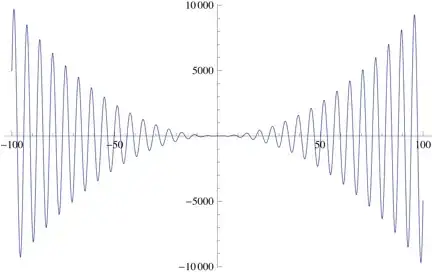Let $R$ be the radius of your spherical cake. We will consider the case when we need to divide the cake into $n$ equally sized pieces.
Each piece will then have volume $\frac{4}{3}\frac{\pi R^3}{n}.$
We can calculate the volume of each slice by setting up a series of integrals, where we integrate over an infinitesimally thin cylinder with volume $dV=\pi r^2 dy,$ where $r\leq R$ is the radius of the cylinder (like this, but where $r$ here is the radius at height $h=R-y$). We have (draw this for yourself to see it) $r^2+y^2=R^2,$ which gives
$$\frac{4}{3}\frac{\pi R^3}{n}=\pi\int_{a_i}^{b_i}(R^2-y^2)dy=\pi\left(R^2(b_i-a_i) +\frac{a_i^3-b_i^3}{3} \right),$$
where $a_i$ is the value of $y$ where the $i$th slice starts and $b_i$ is the value where it ends, with $a_1=-R$ and $b_n=R$. Note that we have $a_{i+1}=b_i.$
We thus have $n$ equations with $n-1$ unknowns:
\begin{align}
\frac{4}{3}\frac{ R^3}{n}&=R^2(b_1-a_1) +\frac{a_1^3-b_1^3}{3}=R^2(b_1-(-R)) +\frac{(-R)^3-b_1^3}{3}\\
&=R^2(b_2-a_2) +\frac{a_2^3-b_2^3}{3}=R^2(b_2-b_1) +\frac{b_1^3-b_2^3}{3} \\
&\quad\quad \quad\;\;\;\;\quad \quad\quad\quad\;\quad\quad \quad\vdots \\
&= R^2(b_n-a_n) +\frac{a_n^3-b_n^3}{3}=R^2(R-b_{n-1}) +\frac{b_{n-1}^3-R^3}{3}.
\end{align}
As this is non-linear, it probably most fruitful to solve it numerically.
For $n=6$, in units of cake-radii (so $R=1$, but we can always scale), we have
$$b_1\approx-0.4817, \quad b_2\approx-0.2261,$$
which is all we need because of the symmetry ($b_3=0$). So your cake/egg-slicer should have distance
$$\Delta b_{01}=0-b_1\approx 0.4817,\Delta b_{12}=b_2-b_1\approx 0.2556,\Delta b_{23}=0-b_2 \approx 0.2261.$$
So your egg-slicer should look a little something like this:
$\quad\quad\quad\;\;\;$
Here is the same as above, but for $n\in[1,20]$:

I must say that I'm surprised how broad the outermost pieces should be in order for them to have a volume equal to the rest, but this is probably my brain not being able to grasp exponentiation (here taking the third power).
Here is the (probably very ugly, but working) Mathematica code:
ClearAll["Global`*"];
M = 20;
For[
n = 1, n < M, n++,
ans = b /.
FullSimplify[
Assuming[Element[n, Integers],
Solve[4/n == 3 (b - a) + a^3 - b^3, b]]];
B[a_] = N[Re[ans[[3]]]];
tabs[n] = {RecurrenceTable[{h[k + 1] == B[h[k]], h[1] == -1},
h, {k, 1, n + 1}]};
]
NumberLinePlot[Table[tabs[k], {k, 1, n}], {x, -1, 1}]
As shown in this answer, we can find the position of the first blade to be (in the case of $R=1$)
$$ x(n)=2\cos \left( {\frac{{\alpha - 2\pi }}
{3}} \right), \quad\quad \text{with } {\,\alpha = \arctan \left( {\frac{{2\sqrt {\left( {n - 1} \right)} }}
{{n - 2}}} \right)}, \text{ for } n>2.$$
But feeding this answer into the next cubic equation and trying to solve just seems masochistic, hence the above call for numerical methods. Note that as $\tan (0)=0$ we have $\lim_{n\rightarrow \infty}x(n)=-1$ as expected.


